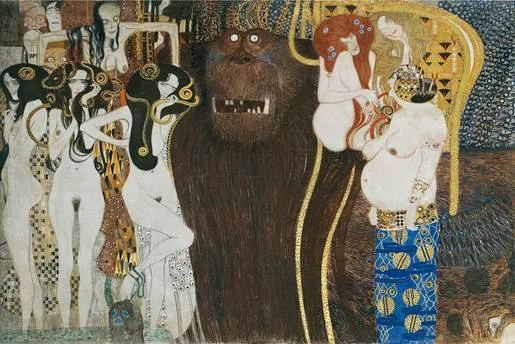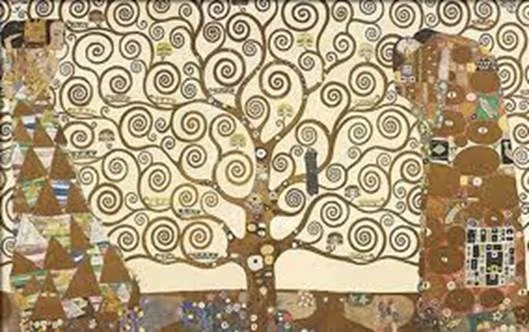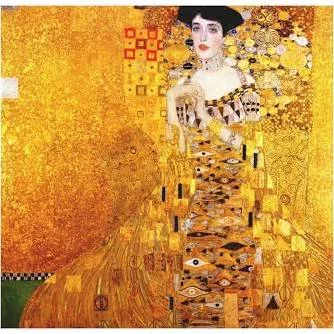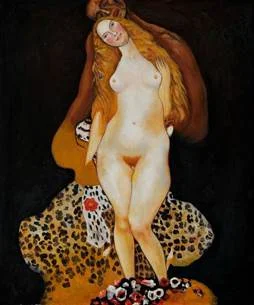Klimt chronology
Date
Event
1862
Gustav Klimt was born July 14, 1862 in Baumgarten, the second of seven children into an impoverished family
1876
At 14, Klimt enters Vienna School of Arts School of Arts and Crafts (Kunstgerwerbeschule), where he would study architectural painting, mosaics and frescoes.
1877
Brother Ernst begins studies at the School of Arts and Crafts along with Gustav
1879
Gustav and Ernst Klimt, along with friend Franz Marsch created a team known as the “Company of Artists” and begin commercial projects
1880
Klimt completes his work Adam and EveThe “Company Artists” was commissioned to paint the ceiling at the Strurany Palace
1881
Gustav Klimt begins illustrations for “Allegorien und Embleme” (Allegories and Emblems)

Allegories and Emblems, 1881
1885
Klimt employs the use of gold leaf for the first time
1886
Begins work with his brother, Ernst, at Burgtheater
1888
Gustav Klimt wins Gold Order of Merit from Emporer Frans Josef I of Austria for contributions to murals in Burgtheater in Vienna and was made honorary member of the University of Munich and the University of Vienna
1891
The Ministry of Education rejects Klimt as professor at Kunstakademie
1891
Klimt became a member of the Cooperative Society of Artists, a conservative artists group that one must belong to if they hoped to make a living as an artist. Klimt would remain a member until 1897.
1892
Commissioned by the Ministry of Culture and Education to decorate the Great Hall of the University representing the four traditional faculties: Theology, Philosophy, Jurisprudence and Medicine. Klimt painted the last of the three and upon completion was incriminated for “pornography” and “excessive perversion”. In response, he would paint The Goldfish, a portrait of a woman showing her naked behind. The Great Hall murals would be Klimt’s last government commission.

The Goldfish, 1892
1897
Klimt, along with numerous other artists frustrated by the conventional norms of the Cooperative Society of Artists, found the Association of Austrian Visual Artists, also known as the Secessionists. Including architects, designers and craftsmen, the Secessionists had three main objectives: provide exhibitions for members, bring Vienna to foreigners and publish magazine Ver Sacrum.
1902
The Secessionists 14th exhibition, in honor of Max Klinger’s Beethoven sculpture, Klimt paints Beethoven Frieze, a wall painting made with light materials that could easily be removed as the piece was meant to only withstand the duration of the exhibition. The work, however, was preserved and not shown again until 1986.
1905-11
Klimt works on the Stoclet Palace, the last remaining house decorated by Klimt. Includes the “Tree of Life” and is heavily inspired by Japanese motifs and contains a three part mosaic comprised of marble, precious stones and gold enamel.

Beethoven Frieze, 1902

Tree of Life, 1905-11
1906
Klimt begins his “Golden Age” first with a Portrait of Fritza Riedler and ends with “Portrait of Adele Bloch-Bauer” in 1907

Portrait of Adele Bloch-Bauer, 1907
1908
After reigning as President of the Secessionist movement, Klimt withdraws from the Secession
1911
Paints “Life and Death”, which won first prize at an international art fair in Rome

Life and Death, 1911
1915
Klimt’s mother dies and his palette becomes substantially darker
1916
Klimt exhibits works in Berlin’s World Fair
1917
Begins work on “Adam and Eve” and “The Bride”

Adam and Eve, 1917
1918
January 11, 1918 Klimt suffers from a stroke that paralyzes his right side leaving him unable to paint and shortly after, on February 6, Klimt succumbs to pneumonia and is buried on the Hietzing Cemetery.